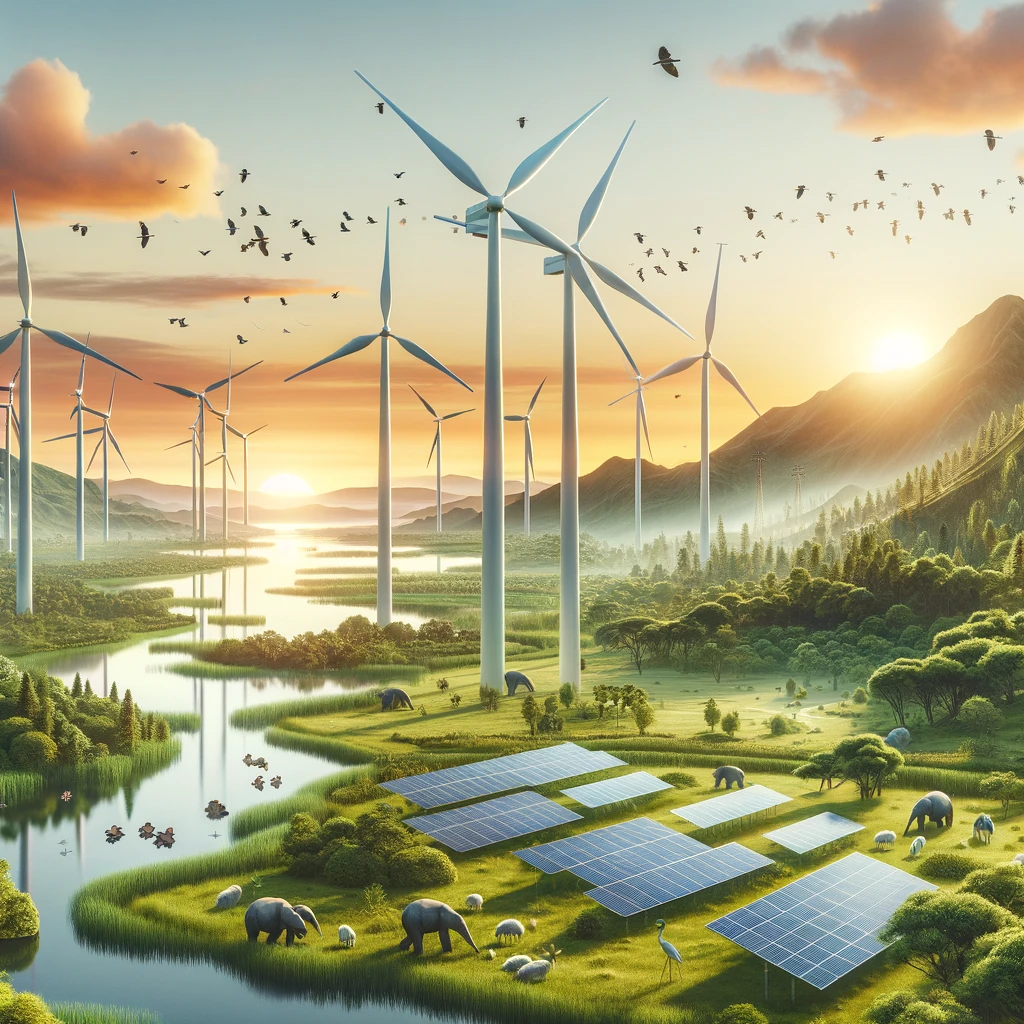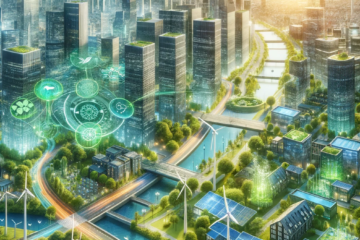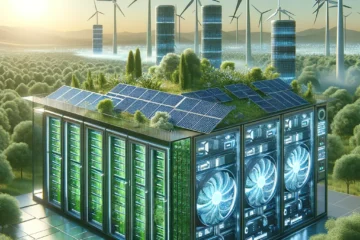Renewable energy has become a cornerstone in the global effort to reduce carbon emissions and combat climate change. However, the expansion of renewable energy projects, such as wind farms and solar arrays, has raised concerns over their impact on wildlife and ecosystems. Balancing the need for clean energy with wildlife conservation requires a nuanced approach, leveraging technological advancements and sustainability principles to mitigate adverse effects and foster a harmonious coexistence.
Renewable Energy Impact on Ecosystems
Renewable energy projects, while essential for reducing reliance on fossil fuels, can have unintended consequences on local wildlife and habitats. Wind turbines, for example, have been associated with bird and bat mortality, while solar farms can disrupt land use and local flora and fauna. Understanding these impacts is crucial for developing strategies that minimize harm and protect biodiversity.
Technological Solutions and Mitigation Measures: Advances in technology offer promising avenues for reducing renewable energy’s negative impact on wildlife. For instance, radar and tracking technologies can help monitor bird movements near wind farms, enabling the turbines to be paused when a high risk of collision is detected. Similarly, solar projects can incorporate land management practices that preserve natural habitats and promote biodiversity.
Policy Frameworks and Environmental Assessments: Effective policy frameworks are essential for ensuring renewable energy projects are developed with wildlife conservation in mind. This includes rigorous environmental impact assessments before project approval, ongoing monitoring, and adapting strategies based on real-world data. Policies encouraging green corridors and wildlife-friendly designs can further align renewable energy development with conservation goals.
Sustainability in Renewable Energy Development
Sustainability goes beyond the generation of clean energy. It encompasses a holistic approach that considers long-term ecological and social impacts. Integrating sustainability into renewable energy projects means prioritizing sites with lower wildlife risks, employing less invasive technologies, and restoring habitats post-installation.
Community Involvement and Education: Engaging local communities and stakeholders in renewable energy projects can foster greater awareness and support for wildlife conservation. Educational programs can highlight the importance of sustainable development and encourage community-led conservation initiatives.
Renewable Energy as a Tool for Conservation: Interestingly, renewable energy can contribute positively to conservation efforts. For instance, protected areas can benefit from clean energy sources that reduce pollution and habitat degradation associated with fossil fuel extraction and use. This dual benefit underscores the potential for renewable energy to support both climate goals and biodiversity.
Technological Advancements Enhancing Coexistence
Innovation is key to resolving the challenges at the intersection of renewable energy and wildlife conservation. Emerging technologies not only improve the efficiency of renewable energy but also its compatibility with environmental stewardship.
Artificial Intelligence and Data Analytics: AI and big data are revolutionizing how we understand and mitigate the impact of renewable energy on wildlife. These technologies can analyze vast amounts of data from monitoring systems, improving predictive models to prevent wildlife collisions and habitat disturbances.
Material Science and Design Innovations: Advances in materials and engineering are leading to more wildlife-friendly renewable energy installations. For example, turbine designs that are less attractive to birds or solar panels that allow for vegetation growth underneath can significantly reduce ecological impacts.
Climate Change, Renewable Energy, and Wildlife
The global push for renewable energy is, at its core, a response to the urgent threat of climate change. While renewable energy projects can pose risks to wildlife, it’s imperative to recognize that unchecked climate change poses an even greater threat to global biodiversity.
Adaptive Strategies for a Changing World: As climate change alters habitats and migration patterns, renewable energy projects must be adaptable. This means planning for the long-term, with flexibility to adjust as ecological conditions change.
The Role of Global Cooperation: Addressing the twin challenges of climate change and wildlife conservation requires global cooperation. International agreements and collaborations can help standardize best practices for renewable energy development and share innovative solutions across borders.
Conclusion
Balancing the impact of renewable energy on wildlife demands a multifaceted approach that integrates technological innovation, sustainability principles, and global cooperation. By prioritizing wildlife conservation in the pursuit of clean energy, we can ensure that our efforts to combat climate change also preserve the planet’s biodiversity. This delicate balance is not only possible but essential for fostering a sustainable future where
Renewable energy has become a cornerstone in the global effort to reduce carbon emissions and combat climate change. However, the expansion of renewable energy projects, such as wind farms and solar arrays, has raised concerns over their impact on wildlife and ecosystems. Balancing the need for clean energy with wildlife conservation requires a nuanced approach, leveraging technological advancements and sustainability principles to mitigate adverse effects and foster a harmonious coexistence.
Renewable Energy Impact on Ecosystems
Renewable energy projects, while essential for reducing reliance on fossil fuels, can have unintended consequences on local wildlife and habitats. Wind turbines, for example, have been associated with bird and bat mortality, while solar farms can disrupt land use and local flora and fauna. Understanding these impacts is crucial for developing strategies that minimize harm and protect biodiversity.
Technological Solutions and Mitigation Measures: Advances in technology offer promising avenues for reducing renewable energy’s negative impact on wildlife. For instance, radar and tracking technologies can help monitor bird movements near wind farms, enabling the turbines to be paused when a high risk of collision is detected. Similarly, solar projects can incorporate land management practices that preserve natural habitats and promote biodiversity.
Policy Frameworks and Environmental Assessments: Effective policy frameworks are essential for ensuring renewable energy projects are developed with wildlife conservation in mind. This includes rigorous environmental impact assessments before project approval, ongoing monitoring, and adapting strategies based on real-world data. Policies encouraging green corridors and wildlife-friendly designs can further align renewable energy development with conservation goals.
Sustainability in Renewable Energy Development
Sustainability goes beyond the generation of clean energy. It encompasses a holistic approach that considers long-term ecological and social impacts. Integrating sustainability into renewable energy projects means prioritizing sites with lower wildlife risks, employing less invasive technologies, and restoring habitats post-installation.
Community Involvement and Education: Engaging local communities and stakeholders in renewable energy projects can foster greater awareness and support for wildlife conservation. Educational programs can highlight the importance of sustainable development and encourage community-led conservation initiatives.
Renewable Energy as a Tool for Conservation: Interestingly, renewable energy can contribute positively to conservation efforts. For instance, protected areas can benefit from clean energy sources that reduce pollution and habitat degradation associated with fossil fuel extraction and use. This dual benefit underscores the potential for renewable energy to support both climate goals and biodiversity.
Technological Advancements Enhancing Coexistence
Innovation is key to resolving the challenges at the intersection of renewable energy and wildlife conservation. Emerging technologies not only improve the efficiency of renewable energy but also its compatibility with environmental stewardship.
Artificial Intelligence and Data Analytics: AI and big data are revolutionizing how we understand and mitigate the impact of renewable energy on wildlife. These technologies can analyze vast amounts of data from monitoring systems, improving predictive models to prevent wildlife collisions and habitat disturbances.
Material Science and Design Innovations: Advances in materials and engineering are leading to more wildlife-friendly renewable energy installations. For example, turbine designs that are less attractive to birds or solar panels that allow for vegetation growth underneath can significantly reduce ecological impacts.
Climate Change, Renewable Energy, and Wildlife
The global push for renewable energy is, at its core, a response to the urgent threat of climate change. While renewable energy projects can pose risks to wildlife, it’s imperative to recognize that unchecked climate change poses an even greater threat to global biodiversity.
Adaptive Strategies for a Changing World: As climate change alters habitats and migration patterns, renewable energy projects must be adaptable. This means planning for the long-term, with flexibility to adjust as ecological conditions change.
The Role of Global Cooperation: Addressing the twin challenges of climate change and wildlife conservation requires global cooperation. International agreements and collaborations can help standardize best practices for renewable energy development and share innovative solutions across borders.
Conclusion
Balancing the impact of renewable energy on wildlife demands a multifaceted approach that integrates technological innovation, sustainability principles, and global cooperation. By prioritizing wildlife conservation in the pursuit of clean energy, we can ensure that our efforts to combat climate change also preserve the planet’s biodiversity. This delicate balance is not only possible but essential for fostering a sustainable future where renewable energy and wildlife thrive together.
Image Request for “Renewable Energy and Wildlife: Balancing the Impact”: A serene landscape showcasing renewable energy installations, such as wind turbines and solar panels, harmoniously integrated into natural habitats, with wildlife visible in the setting, illustrating a successful balance between technological advancement and environmental preservation.
renewable energy and wildlife thrive together.
Image Request for “Renewable Energy and Wildlife: Balancing the Impact”: A serene landscape showcasing renewable energy installations, such as wind turbines and solar panels, harmoniously integrated into natural habitats, with wildlife visible in the setting, illustrating a successful balance between technological advancement and environmental preservation.




